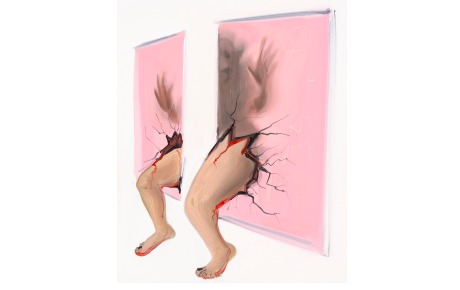Since I knew that Tala Madani doesn’t appreciate talking about her art, this was something I had to begin with when I met her at Moderna Museet in Stockolm two days before the opening today (Friday May 25th) of ”Rip Image”.
I know you prefer your art to be experienced rather than interpreted, which is somehing I can really relate to when writing about art. Since art could be discribed as a kind of language in itself and of it’s own, it’s always problematic to try to translate it to other forms of communication, especially words.
– Yes, excactly, so this is the perfect starting point.
Wonderful. In Sweden I think the cultural sphere is dealing with a lingering view on art, and especially everything sourrounding it, as bourgeoisie, or even aristocratic. Even though it’s clear to most people that the artworld isn’t as capitalistic and conservative as it was until a couple of decades ago there is still that connotation. Especially since the language of art also is something that could be interpreted as esoteric, elitist and therefore excluding.
– Yes and I think we need a new discourse about art because a lot of things has happened, a lot of challenging of positions has been taking place during the last years.
Maybe the notion about political art is changing since the postmodern paradigm has altered our ways of viewing identity, human interaction, discourse and organisation and so on, but being interpreted as having a political agenda is still something that’s not necessarily a smart career move.
– All artists are political. Every work reveals it’s own political position. To create something is a manifestation of a political statement whether it is a conscious desicion or not, whether it’s related to economy, to gender issues or other questions in an explicit way or not. As an artefact, as a human made thing, art has a position, so in that sense all aristst are implicated as being political. To make a dot on a wall, to make the most abstract work is also political in that sense.
In Sweden somewhat of a feminist awakening seems to be happening the Swedish artworld. Your work is sometimes labelled as ”feminist”, do you have any thoughts about that?
– Of course I’m a feminist, I’m a 31 year old woman living in this world, if I wasn’t a feminist what would I be? You have to have a position and you have to constantly be aware of it. It’s not always about gender, sometimes it’s my bofriend that checks me when I slip. He is a writer and he uses as a method to give his characters the ”wrong” gender in the beginning, to try not to reproduce stereoptypes. This is very effective, and because of it he’s sometimes more sensitive than I am to the little, everyday things. At the same time, equality, and the experiences of women, is still very important. The idea that we have reached acceptable levels regarding influence and power between women and men is ludicrous. Women are still catching up with the men, just look at how many female board members there are, so this is an important part of the struggle. What’s also very important is that we as women shouldn’t be som afraid of offending somebody. So what if we do? Sometimes it’s even har to predict what offends people.
I’m sure you have had to deal with people being offended, and misinterpetations of what you do. In what way, if any, would you say that your chosen techniques correlate with ideas, emotions or other things that precede the paintings and pictures?
– My technique embodies my philosophy. I have a higher valuation of play than skill and I go back to something that’s unmediated. The figures of my world are reproducing a kind of child like moment, reaching for something more energetic, more essential, a kind och generative energy.
When Tala Madani rushes back to continue with the installation of her deeply philosophical, political and theoretical exhibition ”Rip Image” she leaves me with a deepened sense of appreciation of her ingenious work, even though she claims she doesn’t like to talk about it. The way childish and strategically simplistic methods are used to depict the once powerful but now pathetic men turn relations between people, whether generational-, gender-, sexual-, ethnic- och other, upside down.
Madani is a truly intersectional artist, not because of her theoretical and political stance and awareness, but, somehow, in spite of it. The title itself is worth a visit at Moderna Museet. The multifaceted claimed death of images could be interpreted as a reference to the image-based culture of today, with the Internet as a whole, Social Media in particular and the increasingly aggressive advertising industry. It’s no wonder Tala Madanis work, picturing white, middle aged men in awkward child like positions is much appreciated.


























MEST KOMMENTERAT
SENASTE KOMMENTARERNA
Om Var Grupp 8 en feministisk organisation?
Om #bildskolan 21: Att äta Den Andre
Om #bildskolan 21: Att äta Den Andre
Om Porr handlar om betalda övergrepp
Om Nobels fredspris till kampanj för att avskaffa kärnvapen
Om Feministiskt perspektiv öppnar arkivet och startar på nytt!
Om Rödgrönt ointresse för fred och nedrustning borde oroa många
Om Var inte målet att vi skulle jobba mindre?
Om Feministiskt perspektiv öppnar arkivet och startar på nytt!
Om Feministiskt perspektiv öppnar arkivet och startar på nytt!
MEST LÄST